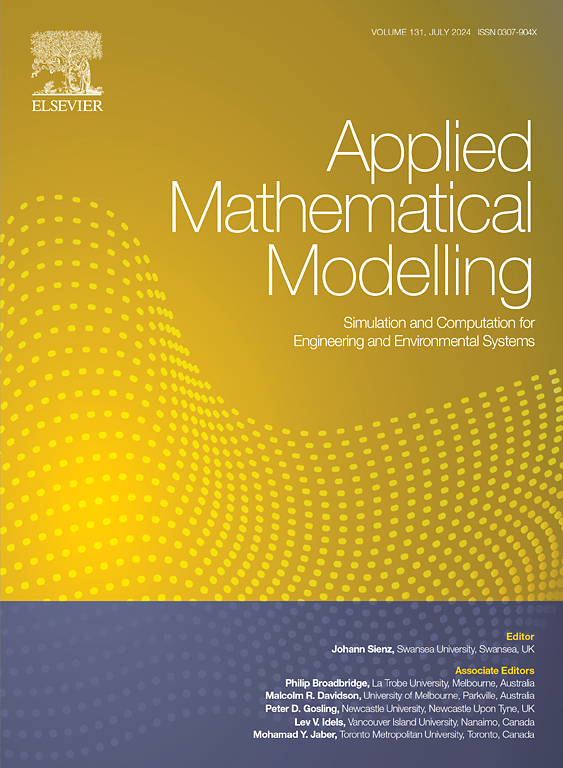A coupled δ+-SPH-NOSB-PD method: Towards fluid-structure interaction problems involving violent free-surface flows and isotropic structural linear elastic deformations and failures
IF 4.4
2区 工程技术
Q1 ENGINEERING, MULTIDISCIPLINARY
引用次数: 0
Abstract
In this paper, a robust integrated particle model is developed by coupling smoothed particle hydrodynamics (SPH) and peridynamics (PD) to deal with the fluid-structure interaction (FSI) problems involving violent free-surface flows and isotropic structural linear elastic deformations and failures. The partitioned approach is conducted in between a stable and accurate -SPH fluid model and a non-ordinary state-based PD (NOSB-PD) structure model based on the idea of non-local interactions. The SPH fluid model is strengthened with a set of previously advanced numerical techniques, hence, the developed coupled scheme is referred to as an enhancement of the traditional SPH-PD. Crack initiation and propagation in structural responses under fluid dynamics are considered, which is relatively rare in previous FSI simulations. The information between the boundaries is transferred via the acceleration-based way and pressure integration method, which helps to ensure numerical stability and accuracy. In addition, a modified sequential staggered (MSS) algorithm is adopted to improve the efficiency when the time step of the structure significantly differs from that of the fluid. Firstly, the performance of the PD-based structure model is verified by three benchmarks, namely a free oscillating cantilever plate, stress distribution inside an isotropic plate with a circular opening and the Kalthoff-Winkler impact test. Then, several challenging FSI problems are simulated to validate the accuracy and robustness of the present FSI solver in predicting the fluid fields and the elastic response and fracture of the structure. The results achieved are in good agreement with the references, verifying the scheme's feasibility in this work.
耦合δ+-SPH-NOSB-PD方法:研究包含剧烈自由表面流动和各向同性结构线弹性变形和破坏的流固耦合问题
本文通过耦合平滑粒子流体力学(SPH)和周流体力学(PD),开发了一种稳健的综合粒子模型,用于处理涉及剧烈自由表面流动和各向同性结构线性弹性变形和破坏的流固相互作用(FSI)问题。这种分区方法是在稳定、精确的 δ+-SPH 流体模型和基于非局部相互作用思想的非平凡状态 PD(NOSB-PD)结构模型之间进行的。SPH 流体模型通过一系列先前的先进数值技术得到了加强,因此,所开发的耦合方案被称为传统 SPH-PD 的增强版。在流体动力学条件下,考虑了结构响应中的裂纹起始和扩展,这在以往的 FSI 模拟中较为罕见。边界之间的信息通过基于加速度的方式和压力积分法进行传递,这有助于确保数值的稳定性和准确性。此外,当结构的时间步长与流体的时间步长相差较大时,采用了改进的顺序交错(MSS)算法来提高效率。首先,通过自由摆动悬臂板、带圆形开口的各向同性板内的应力分布和 Kalthoff-Winkler 冲击试验这三个基准验证了基于 PD 的结构模型的性能。然后,模拟了几个具有挑战性的 FSI 问题,以验证本 FSI 求解器在预测流体场、结构的弹性响应和断裂方面的准确性和稳健性。所取得的结果与参考文献十分吻合,验证了该方案在这项工作中的可行性。
本文章由计算机程序翻译,如有差异,请以英文原文为准。
求助全文
约1分钟内获得全文
求助全文
来源期刊

Applied Mathematical Modelling
数学-工程:综合
CiteScore
9.80
自引率
8.00%
发文量
508
审稿时长
43 days
期刊介绍:
Applied Mathematical Modelling focuses on research related to the mathematical modelling of engineering and environmental processes, manufacturing, and industrial systems. A significant emerging area of research activity involves multiphysics processes, and contributions in this area are particularly encouraged.
This influential publication covers a wide spectrum of subjects including heat transfer, fluid mechanics, CFD, and transport phenomena; solid mechanics and mechanics of metals; electromagnets and MHD; reliability modelling and system optimization; finite volume, finite element, and boundary element procedures; modelling of inventory, industrial, manufacturing and logistics systems for viable decision making; civil engineering systems and structures; mineral and energy resources; relevant software engineering issues associated with CAD and CAE; and materials and metallurgical engineering.
Applied Mathematical Modelling is primarily interested in papers developing increased insights into real-world problems through novel mathematical modelling, novel applications or a combination of these. Papers employing existing numerical techniques must demonstrate sufficient novelty in the solution of practical problems. Papers on fuzzy logic in decision-making or purely financial mathematics are normally not considered. Research on fractional differential equations, bifurcation, and numerical methods needs to include practical examples. Population dynamics must solve realistic scenarios. Papers in the area of logistics and business modelling should demonstrate meaningful managerial insight. Submissions with no real-world application will not be considered.
 求助内容:
求助内容: 应助结果提醒方式:
应助结果提醒方式:


